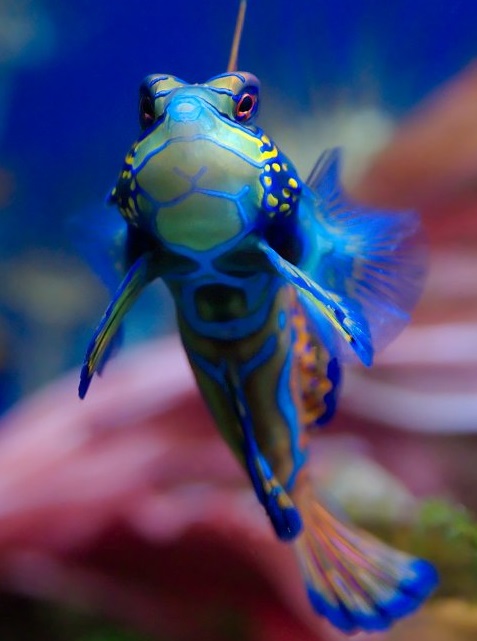Form and Function
Synchiropus splendidus has a unique body form compared to other species. Instead of scales, the mandarinfish has a thick outer mucus and slime covering (Fish Species 2006). This is very helpful to the fish because it protects them against parasites and infection, as well as allows them to better move through water and ward off predators (Fish Species 2006). They have a uniquely foul odor and taste which makes them an unpleasant meal for bigger fish and other predators (Patel 2006). Additionally, mandarinfish have sacciform cells on their skin (Aquatic Community 2008, Patel 2006). These cells produce and release toxins to defend againist potential enemies. This is a huge survival adaptation for the small fish that cannot physically fend off or outswim predators.

The mandarinfish has a very distinctive coloration that is unmatched
in other fish. Its body coloring includes vibrant colors and
variations of green, yellow, orange, brown and blue (Goda, M., R.
Fujiyoshi, M. Sugimoto, and R. Fujii 2013). They are one of two
species that have a rare blue colorization due to light-reflecting
cells and blue pigments (Preuss 2009). Because of its bright colors
and intricate patterns, the mandarinfish is sometimes called “the
psychedelic fish” (Aquatic Community 2008). It features wavy
patterns and lines of color which are not found as vibrantly in
other fish species. These colors help to camouflage the fish in the
colorful coral reefs. It is also an indication of their toxic
features, warning other fish not to prey on them (Aquatic Community
2008). A small number of individuals have a rare reddish ground
coloration (Fish Base 2011). In addition, the colors of the S. splendidus
play a part in mating as they flash their colors during dances to
attract a mate (Preuss 2009). To learn more about the mating of
mandarinfish more information can be found
here.
Most
mandarinfish are under six centimeters, with the largest length ever
recorded a rare seven centimeters which was found in the East Indies
(Fish Base 2011). The fish has a large depressed head (Aquatic
Community 2008) and has four dorsal spines, with no anal spines (Fish
Base 2011). In males the first dorsal spine is elongated making them
larger in size (Patel 2006). Males overall are larger than females
and have a bigger dorsal fin to attract mates (Rasotto, M. B., Y.
Sadovy De Mitcheson, and G. Mitcheson 2010). S. splendidus
use gills to breathe oxygen in water. They have a variety of different
fins including dorsal, ventral, caudal, and pectoral which are used
for different movement. Mandarinfish quickly pulse their fins while
swimming, much like the hovering motions of a hummingbird, though
generally they are slow swimmers (Preuss 2009). S. splendidus
also have larger, fan-like, pelvic fins which they use to walk along
the bottom of the ocean, as seen in the photo above (Patel 2006).
Click here to learn more about the how the mandarinfish reproduces.
Click here to return back
to the home page!